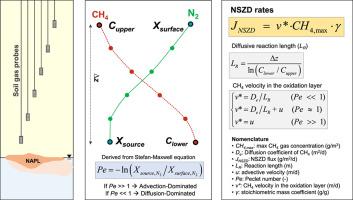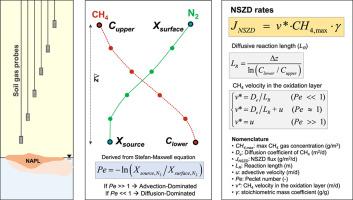石油污染场地甲烷土壤气体梯度法定量测定天然烃源带枯竭率
IF 7.3
2区 环境科学与生态学
Q1 ENVIRONMENTAL SCIENCES
引用次数: 0
摘要
本文提出了一种基于土壤气体中甲烷梯度估算地下轻非水相液体(LNAPL)天然烃源带衰竭(NSZD)速率的新方法。在LNAPL源处通过产甲烷生成甲烷,然后在不饱和区进行甲烷氧化,这是典型的限速降解途径,因此可以作为估计大面积LNAPL NSZD速率的可靠指标。考虑到与自然土壤呼吸过程相关的甲烷生成通常可以忽略不计,因此可以使用该方法直接将甲烷通量转换为NSZD速率。与其他专注于O2、CO2或挥发性有机化合物(VOCs)的方法不同,该方法基于一个分析模型,该模型结合了土壤气体中甲烷的扩散和平流驱动的运输。该模型的应用支持了一般假设,即在空气连接的气包带中,扩散主导着甲烷输送,但在高压梯度(例如10 Pa/m)和高土壤渗透性(例如沙质土壤)的情况下,平流相对于扩散变得重要。此外,分析表明,在大多数情况下,好氧氧化区甲烷的总流速在0.1-1 m/d范围内。通过将该速率乘以土壤气体中最大甲烷浓度和参考碳氢化合物的化学计量系数(例如,辛烷值为1.14 gC8H18/gCH4),可以得出NSZD速率的可靠估计。当应用于典型的土壤气体浓度时,这种甲烷梯度法得出的NSZD估值与文献报道的值一致,验证了其作为一种简化筛选方法的使用。本文章由计算机程序翻译,如有差异,请以英文原文为准。


Methane soil gas gradient method for quantifying natural source zone depletion rates at petroleum contaminated sites
This study presents a novel method that relies on the methane gradient in soil gas for estimating natural source zone depletion (NSZD) rates of light non-aqueous phase liquids (LNAPL) in the subsurface. Methane generation via methanogenesis at the LNAPL source, followed by methane oxidation in the unsaturated zone, is typically the rate-limiting degradation pathway and can, therefore, serve as a reliable indicator for NSZD rate estimation of bulk LNAPL. Considering that methanogenesis associated with natural soil respiration processes is often negligible, this method can be used to directly convert methane fluxes into NSZD rates. Unlike other methods that focus on O2, CO2 or volatile organic compounds (VOCs), this approach is based on an analytical model that incorporates both diffusion and advection-driven transport of methane in soil gas. The application of this model supports the general assumption that diffusion dominates methane transport in the air-connected vadose zone, except in scenarios with high-pressure gradients (e.g., 10 Pa/m) and high soil permeability (e.g., sandy soils), where advection becomes significant relative to diffusion. Additionally, the analysis shows that the overall methane velocity in the aerobic oxidation zone, in most cases, falls within the range of 0.1–1 m/d. By multiplying this velocity by the maximum methane concentration in soil gas and the stoichiometric coefficient of the reference hydrocarbon compound (e.g., 1.14 gC8H18/gCH4 for octane), a reliable estimate of the NSZD rate can be derived. When applied to typical soil gas concentrations, this methane gradient method yields NSZD estimates consistent with values reported in the literature, validating its use as a simplified screening approach.
求助全文
通过发布文献求助,成功后即可免费获取论文全文。
去求助
来源期刊

Environmental Pollution
环境科学-环境科学
CiteScore
16.00
自引率
6.70%
发文量
2082
审稿时长
2.9 months
期刊介绍:
Environmental Pollution is an international peer-reviewed journal that publishes high-quality research papers and review articles covering all aspects of environmental pollution and its impacts on ecosystems and human health.
Subject areas include, but are not limited to:
• Sources and occurrences of pollutants that are clearly defined and measured in environmental compartments, food and food-related items, and human bodies;
• Interlinks between contaminant exposure and biological, ecological, and human health effects, including those of climate change;
• Contaminants of emerging concerns (including but not limited to antibiotic resistant microorganisms or genes, microplastics/nanoplastics, electronic wastes, light, and noise) and/or their biological, ecological, or human health effects;
• Laboratory and field studies on the remediation/mitigation of environmental pollution via new techniques and with clear links to biological, ecological, or human health effects;
• Modeling of pollution processes, patterns, or trends that is of clear environmental and/or human health interest;
• New techniques that measure and examine environmental occurrences, transport, behavior, and effects of pollutants within the environment or the laboratory, provided that they can be clearly used to address problems within regional or global environmental compartments.
 求助内容:
求助内容: 应助结果提醒方式:
应助结果提醒方式:


